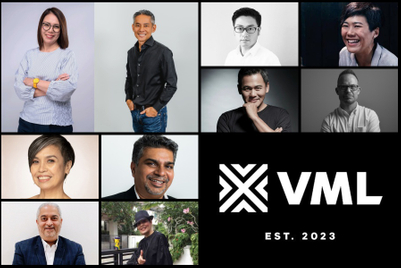
The merger of VMLY&R and Wunderman Thompson has created what WPP chief executive Mark Read described as the "world's biggest creative creativity company". With 30,000 staff working across 64 markets, offering "interconnectivity of brand experience, commerce and customer experiences", VML is undoubtedly an agency of "unprecedented" scale.
Rationalisation lies at the heart of the creative merger, as it does at the continuing "simplification" of Group M's media agency operational model. Together, the two operations account for about two-thirds of revenue and Read hopes to make £100 million (US$122.4 million) savings by 2025 from "structural costs and inefficiencies" across VML and Group M.
It's a figure that is no doubt enticing for chief financial officers and presumably some clients. But what does it tell clients about adland's bread and butter–creative?
Critics, including Now chief executive Louise Hayward, point out that a merger hinged on scale and logistical reach possibly overlooks some basic home truths. Writing in Campaign, she asked: "When do your challenges stop becoming logistical and start becoming about creativity and people? Is this a practical solution to a logistical issue, or does it have the potential to be a creative powerhouse?"
There's an argument against the holding group model (see Ian Whittaker below) that the various agencies within a holding company are not as collaborative as they should be, and therefore that consolidation makes for a more compelling and cohesive offering to advertisers.
But there are counter arguments, not least that the rationale for merging entities is viewed primarily in order to cut costs, not to further creativity.
As others suggest below, to some clients, a merger designed to cut inefficiencies charaterises creative as an asset or cost, rather than as an investment that should be at the heart of the organisation.
Campaign asked some industry figures for their take on the question: will the VML merger lead to other creative agency consolidations?
Rebecca Nunneley
Lead consultant, AAR Group

The creative agency marketplace is hugely oversaturated and competition continues to get tougher and tougher for agencies. With so many shared clients and complementary skillsets, you can understand why WPP took the decision to consolidate two huge brands (VMLY&R and Wunderman Thompson) into one, to simplify and unlock further benefits to clients through their scale.
Will this lead to other creative agency consolidations? I’m not sure. The client benefit of bringing together different creative capabilities to strengthen full-funnel thinking and customer centricity is obvious, but how that works operationally is more complicated. For starters, who do you make the new boss? How do you bring two different cultures together under one roof?
The most successful mergers we see are, in fact, leadership and cultural takeovers. This is just one of the ways agencies can adapt to better answer the current challenges clients are facing but it won’t be right in every case. The positive challenge that comes from multiple agencies can have huge benefits too so I think we will continue to see examples of both playing out successfully for brands and agencies alike.
Ian Whittaker
Founder and managing director, Liberty Sky Advisors

Agency consolidation seems to be the rage. In some ways, it makes sense. One of the arguments used against the agency holding groups is that the individual agency groups do not work as collaboratively as they should and removing the number of agencies can reduce, if not eliminate, the problem. It may also force some clients to move away from the idea that their rivals cannot also be covered by the same agency by reducing their options.
However, there are several risks. The first is that consolidation is seen primarily as a cost-cutting exercise which impacts client performance and morale if not done well. The second is more subtle. Consolidation of assets is a typical move in declining industries. The agencies may be sending a signal that they see creative in such a way (indeed some do). I would argue that is the wrong approach and instead what perhaps should be done is emphasising how creative is an investment, not a cost, which contributes to the bottom line.
Cat Wiles
Chief strategy officer, Lucky Generals

This merger will no doubt spur more agency consolidations, but I believe it’ll only serve to accentuate greater industry division. On one side you have full-funnel creative agencies offering comprehensive services, founded on the belief that bigger is better – yet they risk forgoing the breakthrough creative work this industry craves. On the other, you have smaller agency firebrands who fiercely champion creativity, ground-breaking work and who prioritise their independent spirit over consolidation. This division reflects the age-old tension between the pursuit of scale and the preservation of creative spirit. A raging debate I suspect will continue for years to come.
Faris Yakob
Co-founder, Genius Steals

An Ode to VML
We used to make fun of the old ones
Like law firms with names on the door
Then names became initialisms
Chiat Day is TBWA
And James Walter Thompson no more
Ideas took over for a decade
Mother would look after you
Brands were Naked
(In the eyes of consumers)
And AKQA’s answers were true
Lowe joined octopus Mullen
Adam&Eve and Ned, Mac & Bill
FCB gained and then lost a Draft
But McCann is McCann
And Ogilvy is Ogilvy still
Now VML is biggest
Valentine McCormick Ligibel
HQ Kansas City
(Go Chiefs!)
Let’s all hope they do very well
Today there’s Uncommon,
Mischief @ No Fixed Address
Thinkerbell, Lucky Generals
Rethink, GUT, and Special
Let’s all hope that they transgress.


.jpg&h=334&w=500&q=100&v=20250320&c=1)


.png&h=334&w=500&q=100&v=20250320&c=1)




.png&h=334&w=500&q=100&v=20250320&c=1)








.png&h=268&w=401&q=100&v=20250320&c=1)